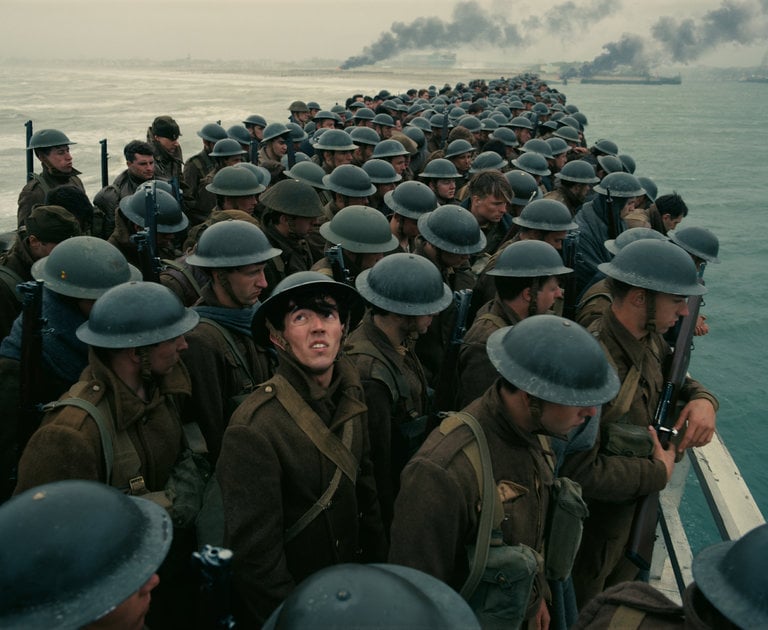
Warner Bros.
Director Christopher Nolan ascribes to the axiom of “show, don’t tell” in his latest film “Dunkirk,” a stunningly shot movie that somehow makes the outcome of war look horrifically beautiful.
The film is by no means a silent movie. Hans Zimmer’s score is blisteringly intense, and the sound editing is poundingly effective as part of Nolan’s depiction of the horrors of war.
New In Local Theaters
- The Black Prince PG-13 1 hr. 58 min.
(Malco Pinnacle)
» Watch trailer - Dunkirk (PG-13) 1 hr. 46 min.
(AMC Fiesta Square, Malco Razorback, Malco Pinnacle)
» Watch trailer - Girls Trip (R) 2hr. 2 min.
(AMC Fiesta Square, Malco Razorback, Malco Rogers Towne)
» Watch trailer - Valerian and the City of a Thousand Planets (PG-13) 2 hr. 17 min.
(AMC Fiesta Square, Malco Razorback, Malco Pinnacle)
» Watch trailer
However, the dialog is sparse. Nolan only uses the words when necessary in telling his version of the Miracle at Dunkirk, in which civilian ships and boats helped evacuate more than 300,000 British, Belgium, French, and Canadian troops across the English Channel from July 26-Aug. 4, 1940, following the Nazi victory at the Battle of Dunkirk.
The monumental effort saved the heart, intellect, and body of Great Britain’s military forces and was a lynchpin in halting the Nazis’ aggression at the English Channel prior the United State entrance in the war in December of 1942, more than a year later.
Without the Miracle of Dunkirk, who knows what the result would have been. It prompted British Prime Minister Winston Chruchill’s famous “We shall fight on the beaches” speech, which helped rally Great Britain during a desperate period of time.
The movie deftly intertwines the action on the beaches, in the air, and on the sea, showing the desperation, heroism, fear, sacrifice and loss faced by all parties in the evacuation. The movie is violent and tense, but not graphic and gory like last fall’s “Hacksaw Ridge.”
Nolan concentrates on the facelessness of war as he presents the story without giving backstory on any of the characters, though accomplished actors such as Mark Rylance, Cillian Murphy, Kenneth Branagh, and Tom Hardy are peppered throughout the film.
Fionn Whitehead and Harry Styles play British Army privates, whose paths merge in the film. Whitehead’s private keeps a more optimistic tone, while Styles’ is a pessimist. That contrast may be a bit simplistic, but it is an effective storytelling device in Nolan’s construction of the movie.
“Dunkirk” is technically an incredibly well-made film that offers a serious portrait of war. Nolan made a bold choice with his stark and somewhat stoic telling of the Miracle at Dunkirk. The story lends itself to a schmaltzy, old-fashioned approach that might have come off as a glorification of war. Nolan certainly avoided that.
However, the film left me wanting something more, although I can’t quite put my finger on exactly what it would be. Maybe a feeling of ambivalence is what Nolan was striving to create in his direction of the film.
(PG-13) 1 hr. 46 min.
Grade: B+
Classic Corner
The Trouble with Harry
Alfred Hitchcock flavored many of his films with dashes of humor, but his 1955 film “The Trouble with Harry” is a straight up romantic comedy, even if it is a bit dark in nature.
Set in an idyllic Vermont village against a sun-soaked Indian summer, the film features a dead body named Harry as Hitchcock’s MacGuffin (plot trigger that has little to do with the actual story), and the movie is the cinematic debut of Shirley MacLaine as Jennifer Rogers, Harry’s twice-widowed wife.
The film also stars Edmund Gwenn, an Oscar winner for his turn as Kris Kringle in “Miracle on 34th Street,” as Captain Wiles; John Forsythe as artist Sam Marlowe; and Mildred Natwick as Miss Gravely. Fans of classic TV shows might also notice that Jennifer’s son Arnie is played by a very young Jerry Mathers just before he garnered the feature role in “Leave It to Beaver.”
While the mystery of who actually killed Harry is at the center of the film’s hijinks, the movie is actually a romantic comedy as Marlowe and Rogers fall in love. Captain Winters and spinster Miss Gravely become a couple, too, during the course of the film as the quartet bury Harry and dig him up several times in the film.
While no one would confuse the movie as one of Hitchcock’s best films, it is a charming movie that proves the director could have made a living directing screwball comedies if he had wanted to.
The film is fast-paced and sparkles with beautiful autumn scenery shot in VistaVision by cinematographer Robert Burks. The score by Bernard Hermann helps set a joyful and light tone.
Turner Classic Movies is showing the film Friday, July 21 at 9:15 p.m. Central, as part of its month-long celebration of Hitchcock’s body of work.

